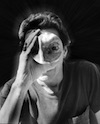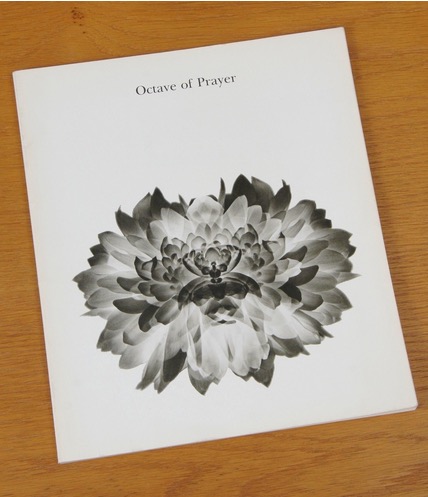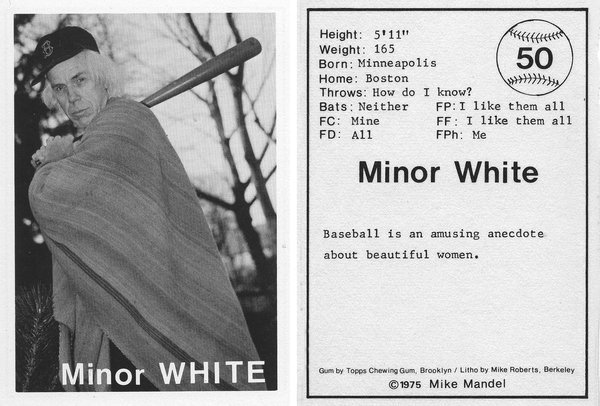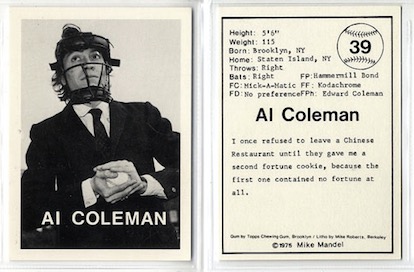 [This was intended for publication as a continuation of what turned out to be the last of my “Latent Image” columns in the Village Voice, which appeared on March 15, 1973. It’s the conclusion of the second half of a two-part critique of the exhibition and catalog Octave of Prayer, which was edited and written by Minor White.
[This was intended for publication as a continuation of what turned out to be the last of my “Latent Image” columns in the Village Voice, which appeared on March 15, 1973. It’s the conclusion of the second half of a two-part critique of the exhibition and catalog Octave of Prayer, which was edited and written by Minor White.
At the time that I drafted it, I knew that this piece would be controversial within the photography community. What I did not foresee was that, after the first part appeared in print, the second part of the piece would so distress a substitute editor at the Voice that he would refuse to run it without major alterations and changes in tone. This led to my backing up the piece as written with a conditional resignation, which the Voice management eventually accepted.
Both parts of the piece were finally run, intact, in the November 1973 issue of Camera 35, for which completion I’d like to thank Jim Hughes, who was then that magazine’s editor. (Subscriber and periodic sponsor A. David Wunsch, who had a copy thereof handy, supplied scans that you can download here as a pdf file.)
![]() Camera 35 billed it as a “Great Debate!!!” and ran a rebuttal from Minor in the same issue. Along with my resignation from the Voice and the accompanying uproar, all that made it hard to put the piece in its proper perspective. Indeed, I’m still not sure what that is; but here, at least, is the piece as it was written, word for word. Click here for Part 1, and here for Part 2. — A.D.C.]
Camera 35 billed it as a “Great Debate!!!” and ran a rebuttal from Minor in the same issue. Along with my resignation from the Voice and the accompanying uproar, all that made it hard to put the piece in its proper perspective. Indeed, I’m still not sure what that is; but here, at least, is the piece as it was written, word for word. Click here for Part 1, and here for Part 2. — A.D.C.]
•
Minor White: Octave of Prayer (IIb)
… “Included,” [White] rambles on, “are images that occupy the mind, images that reach for the heart, those that satisfy the sense-loving body, and especially images that may be grasped intuitively by heart, head, and body simultaneously.” Here White indicates that psychic intuition was the basis for the selection and sequencing of the images in the show. “‘Radiant to the heart’ became the basic criterion for the selection for Octave of Prayer. As a criterion, ‘radiant to the heart’ reduces the terrors of connoisseurship by removing evaluation from the head and putting it in the physical and psychic heart. This criterion makes the whole of photography available to cameraworker, viewer, and critic alike. When seen in depth, the radiant heart sees that all subjects are equally important.” (Italics mine).
Note the value judgments in this paragraph masquerading as definitions. “The terrors of connoisseurship” would seem to be those necessary intellectual risks taken in venturing a verbal interpretation of an image. “Removing evaluation from the head” is a more overt statement of this anti-mind attitude, also revealed in the previous line about “ceasing to needlessly rebel.” “Placing it [evaluation] in the physical and psychic heart” is a remarkable critical construct which implies that the way to tell if it’s a meaningful image is if it makes your heart beat faster. And the statement that “all subjects are equally important” is a rephrasing of that most intellectually debilitating of all religious panaceas, “Is not all one?”
The less thinking anyone does, according to White, the better off we’ll all be, floating around in that famous peace that passeth understanding. No doubt it was that same mindlessness which allowed White to write, further along, “Before man existed, natural symbolism was.” Symbol-making is a peculiarly human function; no other creature invests things with symbolic meaning, and thus before man existed, natural symbolism was not.
It is in the section of text headed “New Photographers” that these anti-intellectual and self-aggrandizing themes manifest themselves most frighteningly. “Today,” White says, “we have come to that impasse of visual overproduction where breakthroughs are an idle fantasy and revitalization of the old is the task of artists and cameraworkers. Whenever a revitalization, a rejuvenation, a resurrection or a regeneration occurs, that image is a glowing contribution to one of the already established traditions.” (Italics mine.) There is no point in trying to find your own path, to do something new and original, he claims. Your task as photographers is to repeat — with variations — the breakthroughs that past gods (among whom White tacitly includes himself) have made. And do not think that you will be able to take credit even for excellent imitation; anytime you succeed, your pictures will be considered only as homage to the gods.
The vanity of this self-serving claptrap is almost too blatant to be believed, and White obviously hasn’t the faintest idea of just how insulting he is being to the intelligence of every young photographer by arrogating to his greater glory not only those photographs turned over to him for exhibitions but every effective image to be made from here on in.
The next three paragraphs, whose inanity is mind-boggling, merit quotation in their entirety.
“While I was embroiled with the contributions of over four hundred photographers, a realization crystallized regarding a demand by new photographers. (“Free, twenty-one, and owns a camera.”) The new photographer is not crushed when I tell him his image has been done a thousand times before and better. He says to me, ‘This is my experience of Isabelle, or a Teton, this is my experience of union with a dead baby in the rubble, this is my experience of a cloud, or a boss I despise. And the favor I ask of you is this: please have the perception and sensitivity to evaluate the depth of my experience.’
‘I know you have the capacity to evaluate the photograph along some certain lines, aesthetic, social, documentary, symbolic, whatever your speciality; but can you evaluate my experience? My union with something is to me a form of reality; and I have felt it in my head, in my heart, in my body. My photograph may not be as strong as Stieglitz’s pictures, as Strand’s pictures, Uelsmann’s or Caponigro’s, but here it is! Do you have the capacity to measure my personal contact and union?’
“Whether I or any other critic or teacher has the capacity to judge the depths and breadths and heights of the new photographer’s rapport, he looks to us for affirmation on the dark road of his Way. He may want photographs to promise stature, or love, or to be told he is headed for stardom. But the unexpected jolt is this: what matters to him more than fame is the depth and validity of his experience. Depth of experience is hard to judge in ourselves, let alone in others, so his question is one that most of us would rather sidestep.”
There is, of course, no such thing as an invalid experience; one’s response to and interpretation of one’s experiences may be sound or not, but the experiences themselves are neither valid nor invalid. And there is absolutely no way of gauging the depth of anyone else’s experience, either. As a critic, I do not consider either of these qualities to be among my concerns. All one can learn from a photograph is how the photographer sees, thinks, and communicates. Most photographers become adept at only the first of these. White has removed from the shoulders of young photographers the obligation to acquire the other two skills — thinking and communicating — and has replaced them with the nebulous non-skill of “feeling” or “experiencing,” which everyone practices from birth. For his following, then, White is specifically calling forth those who do not want their work dealt with critically on any level other than the mystical.
The reason for this is made appallingly clear in the next few sentences. “… While we will probably continue to evaluate still photography according to the going exhibition standards or the criteria of social comment, today we are begged to supplant those standards with our psychic perception of the depth, breadth, and heights of the photographer’s experience of union.
“The spiritual crisis of the times demands that we should heed him. The healing capacity of the process of creative work is desperately needed, now! Let ‘greatness’ appear when it will, we do not need that ego trip. Best of all is the using of art and camerawork consciously for healing no matter for how few the psychological wounds caused by a society destroying itself.” The italics are White’s, and so are the implications: The culture is collapsing around our ears. If we few tender souls choose not to engage ourselves with it, either to repair it or build a new one, but decide instead to retreat to our monasteries and ivory towers and soothe our poor bruised little psyches with pretty, irrelevant imagery, who’s to stop us?
It is not entirely startling that a man capable of such elitism and disengagement from the actions and passions of his time is also capable of saying, in response to adverse criticism of Bruce Davidson’s East 100th Street, “Well, that’s Bruce’s ghetto.”
•
Octave of Prayer is obviously intended to serve as the catechism for converts to an effete estheticism remote from its own age. It tells young photographers that the best they can hope for out of their work is the imitation of past masters in the medium. It tells them that their minds are not only useless but actually antagonistic to the making of images.
 Octave of Prayer represents a man, once a respected and vital teacher and philosopher in photography, coming to believe his own legend and making himself into an institution. This auto-deification is a sad and dangerous turn of events. There was a time when I thought the inferior, derivative imitations of White so often produced by his former students were merely the unfortunate byproducts of his teaching methods. It is apparent from Octave of Prayer that White does not regret his acolytes, but encourages them. I can think of nothing more useless to the medium, or to the world, than the photographic attitudes outlined in such proselytizing fashion within the pages of this book. Its egotism, abuse of power, and irresponsibility are monumental. It seems the time has come for White to be folded up neatly and carefully put away before he gets a chance to hurt himself or anybody else.
Octave of Prayer represents a man, once a respected and vital teacher and philosopher in photography, coming to believe his own legend and making himself into an institution. This auto-deification is a sad and dangerous turn of events. There was a time when I thought the inferior, derivative imitations of White so often produced by his former students were merely the unfortunate byproducts of his teaching methods. It is apparent from Octave of Prayer that White does not regret his acolytes, but encourages them. I can think of nothing more useless to the medium, or to the world, than the photographic attitudes outlined in such proselytizing fashion within the pages of this book. Its egotism, abuse of power, and irresponsibility are monumental. It seems the time has come for White to be folded up neatly and carefully put away before he gets a chance to hurt himself or anybody else.
•
[Postscript, March 2018: Times have certainly changed. I can’t imagine any figure of comparable repute in photography today — as curator, educator, or picture-maker — trying to palm off such sanctimonious balderdash as a curatorial rationale for his own or anyone else’s imagery.
As I wrote in a response to a reader’s comment on Part 1 of this series, White made serious contributions to the medium — as a thinker, teacher, writer, editor, and photographer — that I valued then and continue to value today. In subsequent essays and lectures I’ve paid my respects to those aspects of his work. These curatorial projects don’t number among them. — A.D.C.]
•
 Special offer: If you want me to either continue pursuing a particular subject or give you a break and (for one post) write on a topic — my choice — other than the current main story, make a donation of $50 via the PayPal widget below, indicating your preference in a note accompanying your donation. I’ll credit you as that new post’s sponsor, and link to a website of your choosing. Include a note with your snail-mail address (or email it to me separately) for a free signed copy of my 1995 book Critical Focus!
Special offer: If you want me to either continue pursuing a particular subject or give you a break and (for one post) write on a topic — my choice — other than the current main story, make a donation of $50 via the PayPal widget below, indicating your preference in a note accompanying your donation. I’ll credit you as that new post’s sponsor, and link to a website of your choosing. Include a note with your snail-mail address (or email it to me separately) for a free signed copy of my 1995 book Critical Focus!
 But wait! There’s more! Donate now and I’ll include a copy of The Silent Strength of Liu Xia, the catalog of the 2012-13 touring exhibition of photos by the dissident Chinese photographer, artist, and poet, currently in her sixth year of extralegal house arrest in Beijing. The only publication of her photographic work, it includes all 26 images in the exhibition, plus another 14 from the same series, along with essays by Guy Sorman, Andrew Nathan, and Cui Weiping, professor at the Beijing Film Academy.
But wait! There’s more! Donate now and I’ll include a copy of The Silent Strength of Liu Xia, the catalog of the 2012-13 touring exhibition of photos by the dissident Chinese photographer, artist, and poet, currently in her sixth year of extralegal house arrest in Beijing. The only publication of her photographic work, it includes all 26 images in the exhibition, plus another 14 from the same series, along with essays by Guy Sorman, Andrew Nathan, and Cui Weiping, professor at the Beijing Film Academy.








Allan,
Is there a link to White’s response in either Camera 35 or The Village Voice?
Dear Martin:
Minor did not respond specifically to the first part of the critique when it appeared in the Voice — perhaps because my departure from that paper happened so quickly: one week I was a regular columnist there, then I was gone, with no explanation ever offered by the editors. Several letters got sent to them about my departure (I know because the writers cc’d them to me); the Voice refused to publish them.
I haven’t found any version of Minor’s response in Camera 35 available online. I have a copy in storage, but not immediately accessible. Perhaps some reader can send me a scan as a pdf file, in which case I’ll put it up and post a link thereto. I can tell you that, to his credit, he came out fighting.
And I should add that, while putting my 1979 collection of essays Light Readings into shape for publication, I wrote to the White estate — he died in 1976 — for permission to include his response in that book, along with my challenge. His executor, Peter Bunnell, declined the request.
Some random thoughts:
Minor should be seen as part of an age of gurus– a period lasting from the 60’s into circa 1980. Others of that epoch are, for example, Ram Dass, Werner Erhard, L. Ron Hubbard. Unlike these characters, Minor didn’t seem to have been driven by mercenary concerns. Hubbard is reputed to have said that if you want to become a millionaire in America, start a new religion.
I was delighted when AD singled out Ruth Breil who compared the clicking of shutters at a Yevtushenko reading to a “beautiful…holy poem.” At around the time Allan’s piece appeared, I had been to a Denise Levertov poetry reading at Harvard. A female photographer with a clunky SLR was blasting away. Levertov stopped in mid-sentence and addressed the noodge, saying that she wouldn’t continue unless the shooting stopped. The audience clapped and the reading resumed.
It is hard to imagine that a student influenced by guru Minor could have turned into a Walker Evans, Diane Arbus or Robert Frank. A philosophy that worked for him mostly didn’t transfer. His book Mirrors, Messages, and Manifestations is an impressive piece of work. illustrating his philosophy, and I treasure the copy he signed for me.
He has had an influence. I was part of a group who took a ten day workshop at his home in Arlington, MA in 1966. Over half a century later several of us from that class still meet together to look at and criticize each other’s work. He taught us to take the medium seriously. But none of our work looks like his. We are not, I hope, “minor Minors.”